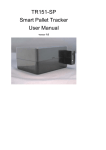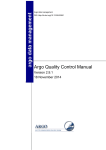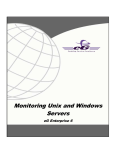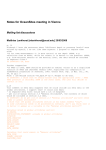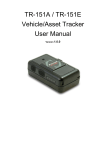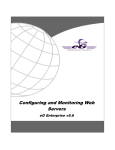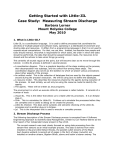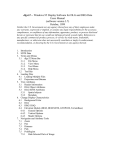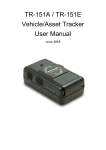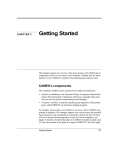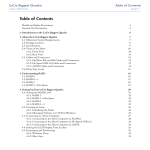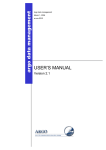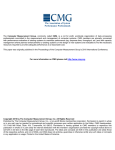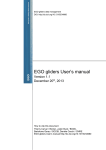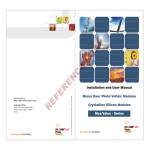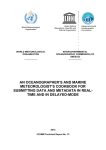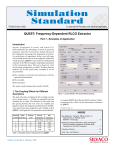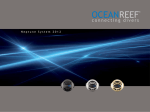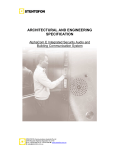Download Argo Quality Control Manual Version 2.1
Transcript
Argo data management November 30th, 2005 ar-um-04-01 Argo quality control manual Version 2.1 Table of contents HISTORY 3 AUTHORS 3 1. INTRODUCTION 4 2. REAL-TIME QUALITY CONTROLS 5 2.1. ARGO R EAL-TIME Q UALITY CONTROL TEST PROCEDURES ON VERTICAL PROFILES 2.1.1. INTRODUCTION 2.1.2. QUALITY CONTROL TESTS 2.1.3. TESTS APPLICATION ORDER 2.2. ARGO R EAL-TIME Q UALITY CONTROL TEST PROCEDURES ON TRAJECTORIES 2.3. ARGO R EAL-TIME SALINITY ADJUSTMENT ON VERTICAL PROFILES 5 5 6 12 13 15 3. 16 DELAYED -MODE QUALITY CONTROLS 3.1. DELAYED - MODE PROCEDURES FOR PRESSURE 3.2. DELAYED - MODE PROCEDURES FOR TEMPERATURE 3.3. DELAYED - MODE PROCEDURES FOR SALIN ITY 3.3.1. INTRODUCTION 3.3.2. QUALITY CONTROL AND THE SEMI- AUTOMATIC PART 3.3.3. SPLITTING THE FLOAT SERIES AND LENGTH OF CALIBRATION WINDOW 3.3.4. THE PI EVALUATION PART 3.3.5. ASSIGNING ADJUSTED SALINITY, ERROR ESTIMATES , AND QC FLAGS 3.3.6. SUMMARY FLOWCHART 3.3.7. WHAT TO SAY IN THE SCIENTIFIC CALIBRATION SECTION OF THE NETCDF FILE 3.3.8. OTHER PARAMETERS IN THE NETCDF FILE 3.3.9. TIMEFRAME FOR AVAILABILITY OF DELAYED- MODE SALINITY DATA 3.3.10. REFERENCES 16 16 17 17 18 18 20 21 23 24 24 25 25 4. 26 4.1. 4.2. APPENDIX REFERENCE TABLE 2: ARGO QUALITY CONTROL FLAG SCALE COMMON INSTRUMENT ERRORS AND FAILURE MODES 26 27 3 History Date 01/01/2002 28/03/2003 08/06/2004 24/10/2003 07/10/2004 23/11/2004 26/11/2004 31/08/2005 17/11/2005 Comment Creation of the document Changed lower limit of temperature in Med to 10.0 Modified spike and gradient tests according to advice from Yasushi and added inversion test Real-time qc test 15 and 16 proposed at Monterey datamanagement meeting, test 10 removed 1. Real-time and delayed mode manuals merged in "Argo quality control manual" 2. Frozen profile real time qc test 17 proposed at Southampton data management meeting. 3. Deepest pressure real time qc test 18 proposed at Southampton data management meeting. 4. Order list for the real time qc tests 5. "Regional Global Parameter Test" renamed "Regional range test", test 7 6. Grey list naming convention and format, test 15 7. Real time qc on trajectories §1 : new introduction from Annie Wong §4 : delayed mode quality control manual from Annie Wong §3 : update of summary flow for delayed mode qc chart p. 21 §2.2 : update on test 17, visual qc §2.3 : added a section on real-time salinity adjustment. §3.1 : added usage of SURFACE PRESSURE from APEX floats. §3.3.5 : added some more guidelines for PSAL_ADJUSTED_QC = '2'. §3.3.8 : clarified that PROFILE_<PARAM>_QC should be recomputed when <PARAM>_ADJUSTED_QC becomes available. See p.24. Authors Annie Wong, Robert Keeley, Thierry Carval, and the Argo Data Management Team. Argo data management quality control manual 30/11/2004 4 1. Introduction This document is the Argo quality control user’s manual. The Argo data system has three levels of quality control. • The first level is the real-time system that performs a set of agreed checks on all float measurements. Real-time data with assigned quality flags are available to users within the 24-48 hrs timeframe. • The second level of quality control is the delayed-mode system. • The third level of quality control is regional scientific analyses of all float data with other available data. The procedures for regional analyses are still to be determined. This document contains the description of the Argo real-time and delayed-mode procedures. Argo data management quality control manual 30/11/2004 5 2. Real-time quality controls 2.1. Argo Real-time Quality Control Test Procedures on vertical profiles 2.1.1. Introduction Because of the requirement for delivering data to users within 24 hours of the float reaching the surface, the quality control procedures on the real-time data are limited and automatic. The test limits are briefly described here. More detail on the tests can be found in IOC Manuals and Guides #22 or at http://www.meds-sdmm.dfo-mpo.gc.ca/ALPHAPRO/gtspp/qcmans/MG22/guide22_e.htm Note that some of the test limits used here and the resulting flags are different from what is described in IOC Manuals and Guides #22. If data from a float fail these tests, those data will not be distributed on the GTS. However, all of the data, including those having failed the tests, should be converted to the appropriate netCDF format and forwarded to the Global Argo Servers. Presently, the TESAC code form is used to send the float data on the GTS (see http://www.meds-sdmm.dfo-mpo.gc.ca/meds/Prog_Int/J-COMM/J-COMM_e.htm). This code form only handles profile data and reports observations as a function of depth not pressure. It is recommended that the UNESCO routines be used to convert pressure to depth (Algorithms for computation of fundamental properties of seawater, N.P. Fofonoff and R.C. Millard Jr., UNESCO Technical Papers in Marine Science #44, 1983). If the position of a profile is deemed wrong, or the date is deemed wrong, or the platform identification is in error then none of the data should be sent on the GTS. For other failures, only the offending values need be removed from the TESAC message. The appropriate actions to take are noted with each test. Argo data management quality control manual 30/11/2004 6 2.1.2. Quality control tests 1. Platform identification Every centre handling float data and posting them to the GTS will need to prepare a metadata file for each float and in this is the WMO number that corresponds to each float ptt. There is no reason why, except because of a mistake, an unknown float ID should appear on the GTS. Action: If the correspondence between the float ptt cannot be matched to the correct WMO number, none of the data from the profile should be distributed on the GTS. 2. Impossible date test The test requires that the observation date and time from the float be sensible. • Year greater than 1997 • Month in range 1 to 12 • Day in range expected for month • Hour in range 0 to 23 • Minute in range 0 to 59 Action: If any one of the conditions is failed, the date should be flagged as bad data and none of the data from the profile should be distributed on the GTS. 3. Impossible location test The test requires that the observation latitude and longitude from the float be sensible. Action: If either latitude or longitude fails, the position should be flagged as bad data and none of the data from the float should go out on the GTS. • Latitude in range -90 to 90 • Longitude in range -180 to 180 4. Position on land test The test requires that the observation latitude and longitude from the float be located in an ocean. Use can be made of any file that allows an automatic test to see if data are located on land. We suggest use of at least the 5-minute bathymetry file that is generally available. This is commonly called ETOPO5 / TerrainBase and can be downloaded from http://www.ngdc.noaa.gov/mgg/global/global.html. Action: If the data cannot be located in an ocean, the position should be flagged as bad data and they should not be distributed on the GTS. Argo data management quality control manual 30/11/2004 7 5. Impossible speed test Drift speeds for floats can be generated given the positions and times of the floats when they are at the surface and between profiles. In all cases we would not expect the drift speed to exceed 3 m/s. If it does, it means either a position or time is bad data, or a float is mislabeled. Using the multiple positions that are normally available for a float while at the surface, it is often possible to isolate the one position or time that is in error. Action: If an acceptable position and time can be used from the available suite, then the data can be sent to the GTS. Otherwise, flag the position, the time, or both as bad data and no data should be sent. 6. Global range test This test applies a gross filter on observed values for temperature and salinity. It needs to accommodate all of the expected extremes encountered in the oceans. • Temperature in range -2.5 to 40.0 degrees C • Salinity in range 0.0 to 41.0 PSU Action: If a value fails, it should be flagged as bad data and only that value need be removed from distribution on the GTS. If temperature and salinity values at the same depth both fail, both values should be flagged as bad data and values for depth, temperature and salinity should be removed from the TESAC being distributed on the GTS. 7. Regional range test This test applies to only certain regions of the world where conditions can be further qualified. In this case, specific ranges for observations from the Mediterranean and Red Seas further restrict what are considered sensible values. The Red Sea is defined by the region 10N,40E; 20N,50E; 30N,30E; 10N,40E and the Mediterranean Sea by the region 30N,6W; 30N,40E; 40N,35E; 42N,20E; 50N,15E; 40N,5E; 30N,6W. Action: Individual values that fail these ranges should be flagged as bad data and removed from the TESAC being distributed on the GTS. If both temperature and salinity values at the same depth both fail, then values for depth, temperature and salinity should be removed from the TESAC being distributed on the GTS. Red Sea • Temperature in range 21.7 to 40.0 • Salinity in range 0.0 to 41.0 Mediterranean Sea • Temperature in range 10.0 to 40 • Salinity in range 0.0 to 40.0 8. Pressure increasing test This test requires that the profile has pressures that are monotonically increasing (assuming the pressures are ordered from smallest to largest). Argo data management quality control manual 30/11/2004 8 Action: If there is a region of constant pressure, all but the first of a consecutive set of constant pressures should be flagged as bad data. If there is a region where pressure reverses, all of the pressures in the reversed part of the profile should be flagged as bad data. All pressures flagged as bad data and all of the associated temperatures and salinities are removed from the TESAC distributed on the GTS. 9. Spike test Difference between sequential measurements, where one measurement is quite different than adjacent ones, is a spike in both size and gradient. The test does not consider the differences in depth, but assumes a sampling that adequately reproduces the temperature and salinity changes with depth. The algorithm is used on both the temperature and salinity profiles. Test value = | V2 - (V3 + V1)/2 | - | (V3 - V1) / 2 | where V2 is the measurement being tested as a spike, and V1 and V3 are the values above and below. Temperature: The V2 value is flagged when • the test value exceeds 6.0 degree C. for pressures less than 500 db or • the test value exceeds 2.0 degree C. for pressures greater than or equal to 500 db Salinity: The V2 value is flagged when • the test value exceeds 0.9 PSU for pressures less than 500 db or • the test value exceeds 0.3 PSU for pressures greater than or equal to 500 db Action: Values that fail the spike test should be flagged as bad data and are removed from the TESAC distributed on the GTS. If temperature and salinity values at the same depth both fail, they should be flagged as bad data and the values for depth, temperature and salinity should be removed from the TESAC being distributed on the GTS. 10. Top and bottom spike test: obsolete 11. Gradient test This test is failed when the difference between vertically adjacent measurements is too steep. The test does not consider the differences in depth, but assumes a sampling that adequately reproduces the temperature and salinity changes with depth. The algorithm is used on both the temperature and salinity profiles. Test value = | V2 - (V3 + V1)/2 | where V2 is the measurement being tested as a spike, and V1 and V3 are the values above and below. Temperature: The V2 value is flagged when • the test value exceeds 9.0 degree C. for pressures less than 500 db or • the test value exceeds 3.0 degree C. for pressures greater than or equal to 500 db Argo data management quality control manual 30/11/2004 9 Salinity : the V2 value is flagged when • the test value exceeds 1.5 PSU for pressures less than 500 db or • the test value exceeds 0.5 PSU for pressures greater than or equal to 500 db Action: Values that fail the test (i.e. value V2) should be flagged as bad data and are removed from the TESAC distributed on the GTS. If temperature and salinity values at the same depth both fail, both should be flagged as bad data and then values for depth, temperature and salinity should be removed from the TESAC being distributed on the GTS. 12. Digit rollover test Only so many bits are allowed to store temperature and salinity values in a profiling float. This range is not always large enough to accommodate conditions that are encountered in the ocean. When the range is exceeded, stored values rollover to the lower end of the range. This rollover should be detected and compensated for when profiles are constructed from the data stream from the float. This test is used to be sure the rollover was properly detected. • Temperature difference between adjacent depths > 10 degrees C • Salinity difference between adjacent depths > 5 PSU Action: Values that fail the test should be flagged as bad data and are removed from the TESAC distributed on the GTS. If temperature and salinity values at the same depth both fail, both values should be flagged as bad data and then values for depth, temperature and salinity should be removed from the TESAC distributed on the GTS. 13. Stuck value test This test looks for all measurements of temperature or salinity in a profile being identical. Action: If this occurs, all of the values of the affected variable should be flagged as bad data and are removed from the TESAC distributed on the GTS. If temperature and salinity are affected, all observed values are flagged as bad data and no report from this float should be sent to the GTS. 14. Density inversion This test uses values for temperature and salinity at the same pressure level and computes the density. The algorithm published in UNESCO Technical Papers in Marine Science #44, 1983 (referred to earlier) should be used. Densities are compared at consecutive levels in a profile. Action: If the density calculated at the greater pressure is less than that calculated at the lesser pressure, both the temperature and salinity values should be flagged as bad data. Consequently, the values for depth, temperature and salinity at this pressure level should be removed from the TESAC distributed on the GTS. Argo data management quality control manual 30/11/2004 10 15. Grey list This test is implemented to stop the real-time dissemination of measurements from a sensor that is not working correctly. The grey list contains the following 7 items: • Float Id • Parameter : name of the grey listed parameter • Start date : from that date, all measurements for this parameter are flagged as bad and probably bad • End date : from that date, measurements are not flagged as bad or probably bad • Flag : value of the flag to be applied to all measurements of the parameter • Comment : comment from the PI on the problem • DAC : data assembly center for this float Each DAC manages a black list, sent to the GDACs. The merged black-list is available from the GDACs. The decision to insert a float parameter in the grey list comes from the PI. Example: Float Id 1900206 Parameter PSAL Start date 20030925 End date Flag 3 Comment Dac IF • Grey list format : ascii csv (comma separated values) • Naming convention : xxx_greylist.csv xxx : DAC name (ex : aoml_greylist.csv, coriolis_greylist.csv, jma_greylist.csv) • PLATFORM,PARAMETER,START_DATE,END_DATE,QC,COMMENT,DAC 4900228,TEMP,20030909,,3,,AO 1900206,PSAL,20030925,,3,,IF 16. Gross salinity or temperature sensor drift This test is implemented to detect a sudden and important sensor drift. It calculates the average salinity on the last 100 dbar on a profile and the previous good profile. Only measurements with good QC are used. Action: if the difference between the 2 average values is more than 0.5 psu then all measurements for this parameter are flagged as probably bad data (flag ‘3’). The same test is applied for temperature: if the difference between the 2 average values is more than 1 degree C then all measurements for this parameter are flagged as probably bad data (flag ‘3’). 17. Visual QC Subjective visual inspection of float values by an operator. To avoid delays, this test is not mandatory before real-time distribution. Argo data management quality control manual 30/11/2004 11 18. Frozen profile test This test can detect a float that reproduces the same profile (with very small deviations) over and over again. Typically the differences between 2 profiles are of the order of 0.001 for salinity and of the order of 0.01 for temperature. A. Derive temperature and salinity profiles by averaging the original profiles to get mean values for each profile in 50dbar slabs (Tprof, T_previous_prof and Sprof, S_previous_prof). This is necessary, because the floats do not sample at the same level for each profile. B. Substract the two resulting profiles for temperature and salinity to get absolute difference profiles: • deltaT=abs(Tprof-T_previous_prof) • deltaS=abs(Sprof-S_previous_prof) C. Derive the maximum, minimum and mean of the absolute differences for temperature and salinity: • mean(deltaT), max(deltaT), min(deltaT) • mean(deltaS), max(deltaS), min(deltaS) D. To fail the test, require that: • max(deltaT) < 0.3 • min(deltaT) < 0.001 • mean(deltaT) < 0.02 • max(deltaS) < 0.3 • min(deltaS) < 0.001 • mean(deltaS) < 0.004 Action: if the profile fails the test, all measurements for this parameter are flagged as bad data (flag ‘4’). If the float fails the test on 5 consecutive cycles, it is inserted in the greylist. 19. Deepest pressure test This test requires that the profile has pressures that DEEPEST_PRESSURE plus 5% 10% 100 dbar (to be defined). are not higher than DEEPEST_PRESSURE value comes from the meta-data file of the float. Action: If there is a region of incorrect pressures, all pressures and corresponding measurements should be flagged as bad data (flag ‘4’). All pressures flagged as bad data and all of the associated temperatures and salinities are removed from the TESAC distributed on the GTS. Argo data management quality control manual 30/11/2004 12 2.1.3. Tests application order The Argo real time QC tests are applied in the order described in the following table. Order test number test name 1 2 3 4 5 6 7 8 9 10 11 12 13 14 15 16 17 18 19 19 Deepest pressure test 1 Platform Identification 2 Impossible Date Test 3 Impossible Location Test 4 Position on Land Test 5 Impossible Speed Test 6 Global Range Test 7 Regional Range Test 8 Pressure Increasing Test 9 Spike Test 10 Top and Bottom Spike Test : removed 11 Gradient Test 12 Digit Rollover Test 13 Stuck Value Test 14 Density Inversion 15 Grey List 16 Gross salinity or temperature sensor drift 18 Frozen profile 17 Visual QC The QC flag value assigned by a test cannot override a higher value from a previous test. Example: a QC flag ‘4’ (bad data) set by Test 11 (gradient test) cannot be decreased to QC flag ‘3’ (bad data that are potentially correctable) set by Test 15 (grey list). Argo data management quality control manual 30/11/2004 13 2.2. Argo Real-time Quality Control Test Procedures on trajectories The following tests are applied in real-time on trajectory data. 1. Platform identification Every centre handling float data and posting them to the GTS will need to prepare a metadata file for each float and in this is the WMO number that corresponds to each float ptt. There is no reason why, except because of a mistake, an unknown float ID should appear on the GTS. Action: If the correspondence between the float ptt cannot be matched to the correct WMO number, none of the data from the profile should be distributed on the GTS. 2. Impossible date test The test requires that the observation date and time from the float be sensible. • Year greater than 1997 • Month in range 1 to 12 • Day in range expected for month • Hour in range 0 to 23 • Minute in range 0 to 59 Action: If any one of the conditions is failed, the date should be flagged as bad data and none of the data from the profile should be distributed on the GTS. 3. Impossible location test The test requires that the observation latitude and longitude from the float be sensible. Action: If either latitude or ol ngitude fails, the position should be flagged as bad data and none of the data from the float should go out on the GTS. • Latitude in range -90 to 90 • Longitude in range -180 to 180 4. Position on land test The test requires that the observation latitude and longitude from the float be located in an ocean. Use can be made of any file that allows an automatic test to see if data are located on land. We suggest use of at least the 5-minute bathymetry file that is generally available. This is commonly called ETOPO5 / TerrainBase and can be downloaded from http://www.ngdc.noaa.gov/mgg/global/global.html Action: If the data cannot be located in an ocean, the position should be flagged as bad data and they should not be distributed on the GTS. Argo data management quality control manual 30/11/2004 14 5. Impossible speed test Drift speeds for floats can be generated given the positions and times of the floats when they are at the surface and between profiles. In all cases we would not expect the drift speed to exceed 3 m/s. If it does, it means either a position or time is bad data, or a float is mislabeled. Using the multiple positions that are normally available for a float while at the surface, it is often possible to isolate the one position or time that is in error. Action: If an acceptable position and time can be used from the available suite, then the data can be sent to the GTS. Otherwise, flag the position, the time, or both as bad data and no data should be sent. 6. Global range test This test applies a gross filter on observed values for temperature and salinity. It needs to accommodate all of the expected extremes encountered in the oceans. • Temperature in range -2.5 to 40.0 degrees C • Salinity in range 0.0 to 41.0 PSU Action: If a value fails, it should be flagged as bad data and only that value need be removed from distribution on the GTS. If temperature and salinity values at the same depth both fail, both values should be flagged as bad data and values for depth, temperature and salinity should be removed from the TESAC being distributed on the GTS. 7. Regional range test This test applies to only certain regions of the world where conditions can be further qualified. In this case, specific ranges for observations from the Mediterranean and Red Seas further restrict what are considered sensible values. The Red Sea is defined by the region 10N,40E; 20N,50E; 30N,30E; 10N,40E and the Mediterranean Sea by the region 30N,6W; 30N,40E; 40N,35E; 42N,20E; 50N,15E; 40N,5E; 30N,6W. Action: Individual values that fail these ranges should be flagged as bad data and removed from the TESAC being distributed on the GTS. If both temperature and salinity values at the same depth both fail, then values for depth, temperature and salinity should be removed from the TESAC being distributed on the GTS. Red Sea • Temperature in range 21.7 to 40.0 • Salinity in range 0.0 to 41.0 Mediterranean Sea • Temperature in range 10.0 to 40 • Salinity in range 0.0 to 40.0 Argo data management quality control manual 30/11/2004 15 2.3. Argo Real-time Salinity Adjustment on vertical profiles When delayed-mode salinity adjustment (see Section 3.3) becomes available for a float, real-time data assembly centres will extract the adjustment from the latest D*.nc file as an additive constant, and apply it to new salinity profiles. (If a better correction is available in real-time, DACs can use that instead.) In this manner, intermediate-quality salinity profiles will be available to users in real-time. The values of this real-time adjustment will be recorded in PSAL_ADJUSTED. PSAL_ADJUSTED_QC will be filled with the same values as PSAL_QC. PSAL_ADJUSTED_ERROR and all parameters in the SCIENTIFIC CALIBRATION section of the netCDF files will be filled with FillValue. A HISTORY record will be appended to the HISTORY section indicating that realtime salinity adjustment has been made. DATA_MODE will record ‘A’. When available, real-time adjusted values are distributed to the GTS, instead of the original values. Argo data management quality control manual 30/11/2004 16 3. Delayed-mode quality controls 3.1. Delayed-mode procedures for pressure Delayed-mode qc for PRES is done by subjective assessment of vertical profile plots of TEMP vs. PRES, and PSAL vs. PRES. This assessment should be done in relation to measurements from the same float, as well as in relation to nearby floats and historical data. The assessment should aim to identify: (a) erroneous data points that cannot be detected by the real-time qc tests, and (b) vertical profiles that have the wrong shape. Bad data points identified by visual inspection from delayed-mode analysts are recorded with PRES_ADJUSTED_QC = ‘4’. For these bad data points, TEMP_ADJUSTED_QC and PSAL_ADJUSTED_QC should also be set to ‘4’. Please note that whenever PARAM_ADJUSTED_QC = ‘4’, • PARAM_ADJUSTED = FillValue; • PARAM_ADJUSTED_ERROR = FillValue. Some float groups that have extra information on surface pressure can perform delayed-mode adjustments for PRES, by comparing measured surface pressure and 0.0 dbar. The results are recorded in PRES_ADJUSTED, PRES_ADJUSTED_ERROR, and PRES_ADJUSTED_QC. Please note that there is no need to recompute PSAL when PRES is adjusted in delayed-mode. Any salinity offset that may result from PRES adjustments can be reflected in PSAL_ADJUSTED. For APEX floats, use next cycle “SURFACE PRESSURE” to adjust PRES if there is evidence that the values reported in “SURFACE PRESSURE” represent significant sensor-related drift or offset. PRES_ADJUSTED, PRES_ADJUSTED_ERROR, PRES_ADJUSTED_QC should be filled even when no adjustment is made. In these cases, PRES_ADJUSTED_ERROR can be the manufacturer’s calibration uncertainty, or uncertainty provided by the PI. Please use the CALIB section in the netCDF files to record the source of the error estimates and any other scientific calibration comments (e.g. surface PRES is automatically reset to zero). 3.2. Delayed-mode procedures for temperature Delayed-mode qc for TEMP is done by subjective assessment of vertical profile plots of TEMP vs. PRES, and PSAL vs. TEMP. This assessment should be done in relation to measurements from the same float, as well as in relation to nearby floats and historical data. The assessment should aim to identify: (a) erroneous data points that cannot be detected by the real-time qc tests, and (b) vertical profiles that have the wrong shape. Bad data points identified by visual inspection from delayed-mode analysts are recorded with TEMP_ADJUSTED_QC = ‘4’. Please note that whenever PARAM_ADJUSTED_QC = ‘4’, • PARAM_ADJUSTED = FillValue; • PARAM_ADJUSTED_ERROR = FillValue. Argo data management quality control manual 30/11/2004 17 TEMP_ADJUSTED, TEMP_ADJUSTED_ERROR, TEMP_ADJUSTED_QC should be filled even when no adjustment is made. In these cases, TEMP_ADJUSTED_ERROR can be the manufacturer’s quoted accuracy at deployment of float. Please use the CALIB section in the netCDF files to record the source of the error estimates and any other scientific calibration comments. 3.3. Delayed-mode procedures for salinity 3.3.1. Introduction Delayed-mode qc for PSAL described in this section are specifically for checking sensor drifts and offsets. Analysts should be aware that there are other instrument errors, and should attempt to identify and adjust them in delayed-mode. If a measurement has been adjusted for more than one instrument error, analysts should attempt to propagate the uncertainties from all the adjustments. The free-moving nature of profiling floats means that most float salinity measurements are without accompanying in-situ “ground truth” values for absolute calibration (such as those afforded by shipboard CTD measurements). Therefore Argo delayed-mode procedures for checking sensor drifts and offsets in salinity rely on reference datasets and statistical methods. However, since the ocean has inherent spatial and temporal variabilities, these drift and offset adjustments are subject to statistical uncertainties. Users therefore should include the supplied error estimates in their usage of Argo delayed-mode salinity data. Two methods are available for detecting sensor drifts and offsets in float salinity, and for calculating adjustment estimates and related uncertainties: 1. Wong, Johnson, Owens (2003) estimates background salinity on a set of fixed standard isotherms, then calculates drifts and offsets by time-varying weighted least squares fits between vertically-interpolated float salinity and estimated background salinity. This method suits float data from open tropical and subtropical oceans. For the related software, please contact Annie Wong at [email protected]. 2. Boehme and Send (2005) takes into account planetary vorticity in its estimates of background salinity, and chooses a set of desirable isotherms for calculations. This method suits float data from oceans with high spatial and temporal variabilities, where water mass distribution is affected by topographic barriers, and where multiple water masses exist on the same isotherm. For the related software, please contact Lars Boehme at [email protected]. Both methods require an adequate reference database and an appropriate choice of spatial and temporal scales, as well as input of good/adjusted float pressure, temperature, position, and date of sampling. Therefore analysts should first check the reference database for adequacy and determine a set of appropriate spatial and temporal scales before using these methods. Operators should also ensure that other float measurements (PRES, TEMP, LATITUTDE, LONGITUDE, JULD) are accurate or adjusted before they deal with float salinity. See Secions 3.1 and 3.2 for delayed-mode procedures for PRES and TEMP. Argo data management quality control manual 30/11/2004 18 3.3.2. Quality control and the semi-automatic part The real-time qc procedures (described in Section 2) issue a set of qc flags that warns users of the quality of the float salinity. These are found in the variable PSAL_QC. Float salinity with PSAL_QC = ‘4’ are bad data that are in general unadjustable. However, delayed-mode operators can evaluate the quality and adjustability of these bad data if they have a reason to do so. Please refer to Section 4.1 for definitions of the Argo qc flags in real-time. In delayed-mode, float salinity that have PSAL_QC = ‘1’, ‘2’ or ‘3’ are further examined. Anomalies in the relative vertical salinity profile, such as measurement spikes and outliers that are not detected in real-time, are identified. Of these anomalies, those that will skew the least squares fit in the computation for drift and offset adjustments are excluded from the float series for evaluation of drifts and offsets. These measurements are considered unadjustable in delayed-mode. Float salinity that are considered adjustable in delayed-mode are assembled into time series, or float series. Sufficiently long float series are compared with statistical recommendations and associated uncertainties to check for sensor drifts and offsets. These statistical recommendations and associated uncertainties are obtained by the accepted methods listed in Section 3.3.1, in conjunction with appropriate reference datasets. These methods are semi-automatic and have quantified uncertainties. Drifts and offsets can be identified in the trend of ∆S over time, where ∆S is the difference in salinity between float series and statistical recommendations. If ? S = a + bt where t is time, then a is the offset and b is the drift. Note that these drifts and offsets can be sensor-related, or they can be due to real ocean events. PI evaluation is needed to distinguish between sensor errors and real ocean events. 3.3.3. Splitting the float series and length of calibration window If a float exhibits changing behaviour during its lifetime, the float series should be split into separate segments according to the different behaviours, so that one float series segment does not contaminate the other during the least squares fit process (e.g. the slowly-fouling segment does not contaminate the stable segment). Argo data management quality control manual 30/11/2004 19 The following is a step-by-step guide on how to deal with float series with changing behaviours. 1). Identify different regimes in the float series. These can be: • Stable measurements (no sensor drift), including constant offsets. • Sensor drift with a constant drift rate. • Transition phase where drift rate changes rapidly e.g. (a) ‘elbow region’ between stable measurements and constant drift; (b) initial biocide wash-off. • Spikes. 2). Split the float series into discrete segments according to these different regimes or when there are too many missing cycles. Here is an example. ?S Constant offset Discontinuity (no transition phase) Sensor drift with a constant drift rate Transition phase Spike Stable time 3). Choose length of sliding calibration window for each segment. These can be: • Long window (+/- 6 months or greater) for the stable regime, or highly variable regimes where a long window is required to average over oceanographic variability to detect slow sensor drift, or period of constant drift rate. • Short window (can be as short as +/- 10 days) for the transition phase. • Zero length window for spikes. That is, adjust single profile. 4). Select temperature levels for exclusion from least squares fit (e.g. seasonal mixed layer, highly variable water masses). Argo data management quality control manual 30/11/2004 20 5). Calculate proposed adjustment for each segment. The assembled proposed adjustments for the entire float series should be continuous and piecewise-linear within error bars, except where the delayed-mode operator believes there is a genuine discontinuity. In general, the delayed-mode operator should aim to use as long a calibration window as possible, because a long calibration window (where the least squares fit is calculated over many cycles) will average over oceanographic noise and thus give a stable calibration. Hence splitting the float series into short segments is to be avoided (short segments mean short calibration windows, hence unstable calibrations). 3.3.4. The PI evaluation part The PI (here, PI means Principal Investigator, or responsible persons assigned by the PI) should first check that the statistical recommendations are appropriate. This is because the semi-automatic methods cannot distinguish ocean features such as eddies, fronts, and water mass boundaries. Near such ocean features, semi-automatic statistical methods are likely to produce erroneous estimations. The associated uncertainties reflect the degree of local variability as well as the sparsity of reference data used in the statistical estimations. However, these associated uncertainties are sensitive to the choice of scales. Hence the PI also needs to determine that the associated uncertainties are realistic. The PI then determines whether the proposed statistical adjustment is due to sensor malfunction or ocean variability. Care should be taken to not confuse real ocean events with sensor drifts and offsets. This is done by inspecting as long a float series as possible, and by evaluating all available independent information. Some of the diagnostic tools can include: • Inspecting the trend of ∆S over time. Trends that reverse directions, or oscillate, are difficult to explain in terms of systematic sensor malfunction. These are often caused by the float sampling oceanographic features (e.g. eddies, fronts, etc.) that are not adequately described in the reference database. • Visual check of float trajectory with reference to oceanographic features such as eddies and rings that can introduce complications to the semi-automatic methods. • Inspecting contour plots of float salinity anomaly time series. Systematic sensor malfunction should show up as salinity anomalies over several water masses. • Using other independent oceanographic atlases to anticipate water mass changes that can occur along a float’s path, and that can be misinterpreted as sensor malfunction. • Inspecting residuals from objective maps. • Cross-checking with nearby stable floats in cases of suspect sensor calibration offset. If the PI is confident that sensor malfunction has occurred, then the threshold for making an adjustment is when ?S is greater than 2 times whatever is reported in PSAL_ADJUSTED_ERROR. By default this will be the error from the statistical methods, but the PI can provide an alternative estimate of uncertainty if they have a basis for doing so. Note that this guideline is to help the PI in deciding whether a slope or offset is statistically significant, and so should be used to evaluate the entire float segment being fitted, and not to single points. Argo data management quality control manual 30/11/2004 21 The lower bound on the size of an adjustment is the instrument accuracy. At present, there is no upper bound for the magnitude of salinity adjustment. In cases where the float series has been split into separate segments, the PI must ensure that the assembled adjustment for the entire float series is continuous within error bars, except where the PI believes there is a genuine discontinuity (see Step 5 in Section 3.3.3). This is to ensure that no artificial jump is introduced where the separate segments join. Adjustment continuity between separate float segments can be achieved by making adjustment in the transition phase even though the adjustment is below the 2 times error threshold limit. In the following example, the float series experiences sensor drift after a stable period. The float series has been split for calibration. However, the float series has no discontinuity, so the final assembled adjustment should be continuous. Adjustment continuity is achieved by using model (a) and not (b). 3.3.5. Assigning adjusted salinity, error estimates, and qc flags After evaluating all available information, the PI then assigns adjusted salinity values, error estimates, and delayed-mode qc flags. In Argo netcdf files, these are found respectively in the parameters PSAL_ADJUSTED, PSAL_ADJUSTED_ERROR, and PSAL_ADJUSTED_QC. Please refer to Section 4.1 for definitions of the Argo qc flags in delayed-mode. The original float salinity and real-time qc flags remain in the parameters PSAL and PSAL_QC, and are never altered in delayed-mode. A Matlab-based graphical user interface for interacting with Argo netcdf files has been developed by John Gilson at Scripps Institute of Oceanography. Please contact [email protected]. The following is a set of guidelines for assigning values to PSAL_ADJUSTED, PSAL_ADJUSTED_ERROR and PSAL_ADJUSTED_QC in Argo netcdf files. When no delayed-mode qc is available For example, when the netcdf file is still in real-time mode, or when there is no LATITUDE, LONGITUDE, or JULD (hence no statistical recommendation available). Argo data management quality control manual 30/11/2004 22 • PSAL_ADJUSTED = FillValue; • PSAL_ADJUSTED_ERROR = FillValue; • PSAL_ADJUSTED_QC = FillValue. For float salinity that are considered unadjustable in delayed-mode For example, large spikes, or extreme behaviour where the relative vertical T-S shape does not match good data. These measurements are unadjustable. • PSAL_ADJUSTED = FillValue; • PSAL_ADJUSTED_ERROR = FillValue; • PSAL_ADJUSTED_QC = ‘4’. For float salinity that are considered adjustable in delayed-mode These measurements have a relative vertical T-S shape that is close to good data. They are evaluated and adjusted for sensor drifts, offsets, and any other instrument errors. i). When no adjustment is needed, • PSAL_ADJUSTED = PSAL (original value); • PSAL_ADJUSTED_ERROR = max [statistical uncertainty, instrument accuracy], or uncertainty provided by PI; • PSAL_ADJUSTED_QC = ‘1’, ‘2’, or ‘3’. ii). When an adjustment has been applied, • PSAL_ADJUSTED = value recommended by statistical analyses, or adjustment provided by PI; • PSAL_ADJUSTED_ERROR = max [statistical uncertainty, instrument accuracy], or uncertainty provided by PI; • PSAL_ADJUSTED_QC = ‘1’, ‘2’, or ‘3’. iii). When the PI determines that float salinity are bad and unadjustable, • PSAL_ADJUSTED = FillValue; • PSAL_ADJUSTED_ERROR = FillValue; • PSAL_ADJUSTED_QC = ‘4’. The following are some cases where a flag ‘2’ should be assigned • Adjustment is based on unsatisfactory reference database. • Adjustment is based on a short calibration window (because of sensor behaviour transition, or end of sensor life) and therefore may not be stable. • Evaluation is based on insufficient information. • Sensor is unstable (e.g. magnitude of adjustment is too big, or sensor has undergone too many sensor behaviour changes) and therefore data are inherently of mediocre quality. • When a float exhibits problems with its pressure measurements. Argo data management quality control manual 30/11/2004 23 3.3.6. Summary flowchart Argo salinity sensor drift & offset QC procedures Manual evaluation to detect anomalies on the relative profile, such as spikes, that are not detected in RT. Remove anomalies that may skew the drift/offset correction. Do not use in least squares fit. PSAL_ADJUSTED = FillValue PSAL_ADJUSTED_ERROR = FillValue PSAL_ADJUSTED_QC = 4 Use in least squares fit. Use accepted methods and reference database, split series and select appropriate length for the sliding window, to calculate recommended salinity adjustments. PI evaluation - consider long time series and other supporting information to determine whether sensor malfunction has happened. No sensor error has been detected, or sensor drift and/or offset is not significant Sensor drift and/or offset has been detected and is significant < max [ 2 x statistical uncertainty, instrument accuracy ] > max [ 2 x statistical uncertainty, instrument accuracy ] Apply adjustment, or declare unadjustable. No adjustment needed. PSAL_ADJUSTED = PSAL (original value) PSAL_ADJUSTED_ERROR = max [statistical uncertainty, instrument accuracy], or uncertainty provided by PI PSAL_ADJUSTED_QC = 1, 2 or 3 PSAL_ADJUSTED = value recommended by statistical analyses, or adjustment provided by PI PSAL_ADJUSTED_ERROR = max [statistical uncertainty, instrument accuracy], or uncertainty provided by PI PSAL_ADJUSTED_QC = 1, 2 or 3 OR Last update :19-Apr-05 Argo data management PSAL_ADJUSTED = FillValue PSAL_ADJUSTED_ERROR = FillValue PSAL_ADJUSTED_QC = 4 quality control manual 30/11/2004 24 3.3.7. What to say in the scientific calibration section of the netcdf file Within each single-profile Argo netcdf file is a scientific calibration section that records details of delayed-mode adjustments. In this scientific calibration section, for every parameter listed in PARAMETER (PRES, TEMP, PSAL), there are four fields to record scientific calibration details: • SCIENTIFIC_CALIB_EQUATION; • SCIENTIFIC_CALIB_COEFFICIENT; • SCIENTIFIC_CALIB_COMMENT; • CALIBRATION_DATE. In cases where no adjustment has been made, SCIENTIFIC_CALIB_EQUATION and SCIENTIFIC_CALIB_COEFFICIENT shall be filled by their respective FillValue. SCIENTIFIC_CALIB_COMMENT shall contain wordings that describe the evaluation, e.g. “No adjustment is needed.” In cases where adjustments have been made, examples of wordings for PSAL can be: SCIENTIFIC_CALIB_EQUATION: “PSAL_ADJUSTED = PSAL + ? S, where ? S is calculated from a potential conductivity (ref to 0 dbar) multiplicative adjustment term r.” SCIENTIFIC_CALIB_COEFFICIENT: “r = 0.9994 (± 0.0001), vertically averaged ? S = − 0.025 (± 0.003).” SCIENTIFIC_CALIB_COMMENT: “Sensor drift detected. Adjusted float salinity to statistical recommendation as in WJO (2003), with WOD2001 as the reference database. Mapping scales used are 8/4, 4/2. Length of sliding calibration window is +/- 20 profiles” The PI is free to use any wordings he/she prefers. Just be precise and informative. Regardless of whether an adjustment has been made, the date of calibration of each parameter (PRES, TEMP, PSAL) should be recorded in CALIBRATION_DATE. 3.3.8. Other parameters in the netcdf file A history record should be appended to the HISTORY section of the netcdf file to indicate that the netcdf file has been through the delayed-mode process. Please refer to the Argo User’s Manual (§5 “Using the History section of the Argo netCDF Structure”) on usage of the History section. The parameter DATA_MODE should record ‘D’. The parameter DATA_STATE_INDICATOR should record ‘2C’. The parameter DATE_UPDATE should record the date of last update of the netcdf file. The parameters PROFILE_<PARAM>_QC <PARAM>_ADJUSTED_QC becomes available. should be recomputed when Lastly, the name of the single-profile Argo netcdf file is changed from R*.nc to D*.nc. Argo data management quality control manual 30/11/2004 25 3.3.9. Timeframe for availability of delayed-mode salinity data The statistical methods used in the Argo delayed-mode process for checking sensor drifts and offsets in salinity require the accumulation of a time series for reliable evaluation of the sensor trend. Timeframe for availability of delayed-mode salinity data is therefore dependent on the sensor trend. Some floats need a longer time series than others for stable calibration. Thus delayed-mode salinity data for the most recent profile may not be available until sufficient subsequent profiles have been accumulated. The default length of time series for evaluating sensor drift is 12 months (6 months before and 6 months after the profile). This means that in general, the timeframe of availability of drift-adjusted delayed-mode salinity data is 6+ months after a profile is sampled. Users should also be aware that changes may be made to delayed-mode files at any time by DACs and delayed-mode operators. For example, delayed-mode files may be revised when new CTD or float data become available after the original delayed-mode assessment and adjustment. The date of latest adjustment of a parameter can be found in CALIBRATION_DATE. Anytime an Argo file is updated for any reason, the DATE_UPDATE variable will reflect the date of the update. The "profile index file" on the GDACs contains the DATE_UPDATE information (along with other information) for every file on the GDACs and can be used to monitor updates. The profile index file is maintained in the top-level GDAC directory and is named "ar_index_global_prof.txt"; index files also exist for the meta-data and trajectory files. 3.3.10. References Böhme, L. and U. Send, 2005: Objective analyses of hydrographic data for referencing profiling float salinities in highly variable environments, Deep-Sea Research II, 52/3-4, 651-664. Wong, A.P.S., G.C. Johnson, and W.B. Owens, 2003: Delayed-mode calibration of autonomous CTD profiling float salinity data by θ-S climatology. Journal of Atmospheric and Oceanic Technology, 20, 308-318. Argo data management quality control manual 30/11/2004 26 4. Appendix 4.1. Reference Table 2: Argo quality control flag scale This table describes the Argo qc flag scales. Please note that this table is used for all measured parameters. This table is named Reference Table 2 in the Argo User’s Manual. n Meaning No QC was 0 performed Real-time comment Delayed-mode comment No QC was performed 1 Good data Probably good 2 data All Argo real-time QC tests passed. No QC was performed The adjusted value is statistically consistent and a statistical error estimate is supplied. Probably good data Test 15 or Test 16 or Test 17 failed and all other real-time QC tests passed. These data are not to be used without scientific correction. A flag ‘3’ Probably bad data may be assigned by an operator during that are potentially additional visual QC for bad data that may be 3 correctable corrected in delayed-mode. Data have failed one or more of the real-time QC tests, excluding Test 16. A flag ‘4’ may be assigned by an operator during additional visual 4 Bad data QC for bad data that are uncorrectable. Probably good data 5 6 7 8 9 Value changed Not used Not used Interpolated value Missing value Value changed Not used Not used Interpolated value Missing value Argo data management Value changed Not used Not used Interpolated value Missing value quality control manual An adjustment has been applied, but the value may still be bad. Bad data. Not adjustable. 30/11/2004 27 4.2. Common instrument errors and failure modes This section describes some common instrument errors and failure modes that will cause error in float measurements. 1. TBTO leakage TBTO (tributyltinoxide) is a wide spectrum poison that is used to protect conductivity cells from biofouling. However, accidental leakage of TBTO onto the conductivity cell can occur. This will result in fresh salinity offsets in float series that usually gets washed off. Delayed-mode analysts should pay special attention to the shape of the salinity profiles at the beginning of the float series if TBTO leakage is suspected. 2. Pollution events Any pollution on the conductivity cell will result in erroneously fresh salinity measurements. When pollution washes off, reversal of sensor drift trend can occur. Delayed-mode analysts need to be careful in splitting float series in such cases. 3. Ablation events Any ablation of the conductivity cell, such as etching, scouring, or dissolution of the glass surface, will result in erroneously salty salinity measurements. 4. Cell geometry changes The geometry of conductivity cells can change, thus causing electrodes to change distance. This will result in either an increase or decrease in salinity values. 5. Cell circuit changes The circuit within the conductivity cell contains capacitors and resistors. Changes to any of these electrical components will affect electrical conductivity and thus will give erroneous (fresh or salty) salinity measurements. Electrical complication can result in sensor drifts that have varying drift rates (e.g. drift rates can change from slow and linear to exponential). Usually jumps in salinity measurements are an indication of electrical malfunction. If electrical complication is suspected, delayed-mode analysts should check the shape of the vertical salinity profiles for adjustability. Usually the vertical profiles after a measurement jump are wrong and so are uncorrectable. 6. Low voltage at end of float life, and “Energy Flu” APEX floats often experience a sudden rapid decrease in available battery energy reserves. This premature exhaustion of battery, known as “Energy Flu”, usually starts about 2 years after deployment. The sharp drop in battery voltage related to “Energy Flu”, as well as the low voltage towards the end of a float’s natural life, will cause spiky erratic measurements that will make it difficult for delayed-mode analysts to determine where to split the float series and how to fit a slope. Towards the end of float life, low voltage will result in large drift, followed by death. “Energy Flu” will cause spikes that get worse and more frequent, also followed by death. 7. Druck sensor problem About 4% of SBE41s have experienced the Druck pressure sensor defect. SeaBird has fixed this problem, so this feature is only included in this section for identifying the profiles that have been affected. The Druck sensor problem is caused by oil getting into the pressure sensor, causing the sensor to report either PRES ~ (+) 3000 dbar or (-) 3000 dbar. The pressure sensor tries to adjust the piston to the “fooled” pressure, and so Argo data management quality control manual 30/11/2004 28 progressively becomes a surface drifter. The problem usually starts with a profile that reports measurements from very close-together depth levels. Both temperature and salinity measurements are useless from that stage onward. 8. Incorrect pressure sensor coefficient Incorrect scaling coefficient in the pressure sensor will give anomalous T-S curves at depth. The T-S relation will look acceptable, but at depth it will look as if the float is sampling an anomalous water mass relative to nearby floats. Delayed-mode analysts should try to re-scale pressure measurements (e.g. PRES’ = PRES * X) to see whether the T-S curve can be recovered. Air bubbles in the pressure transducer can also cause erroneous pressure measurements that are visible as anomalous T-S curves. 9. Thermal inertia lag Salinity reported immediately after a float has crossed a strong thermal gradient can be in error as a result of conductivity cell thermal mass. This error arises because of heat exchange between the conductivity cell and the water within it. A float that transits from cold to warm water can result in fresh error, and from warm to cold in salty error. These errors can exceed 0.01 (PSS-78) for strong thermal gradients, and sometimes result in unstable fresh spikes at the base of the mixed layer. Argo data management quality control manual 30/11/2004




























